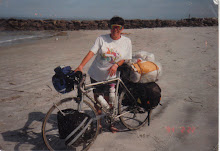From the job postings at the local university, it became apparent to me that the school valued staff members with the "ability to multi-task and work cooperatively with others."
If that boilerplate is true, the human resources department should consider passing out applications at all the coffee shops in town. Never have I multitasked nor worked as cooperatively with others—under such pressure—as while waiting tables during a busy lunch.
Waiting tables is a heck of a lot more skilled than unskilled labor, contrary to popular belief. Of my former office-working brethren, I'd reckon that a mere 10% could successfully wait tables through a rush.
Every table is in a different phase of the meal: drinks, salad, entree, check back, refills, dessert, check, change. To the clientele I present a facade that is variously friendly, wise-cracking, flirtatious, unflappable, indulgent, efficient, witty, respectful...but always attentive. The ability to continually juggle the various stages of the meal for several tables, while greeting people, dealing with cooks, punching in orders on the touchscreen, carrying heavy plates, appearing cheerful and chipper...it's not for the timid. On top of that, we are expected to remember the nuances of every regular customer's order: no cucumbers on the salad, French dressing, dry hamburger, no ice in the drink.
To make things even more complicated, entrees are placed in the window with no documentation as to which waitress, or even table, they go to. We just sort it out.
And we make it look easy.
It's not.
And then there is the interface with the cooks, who turn out a prodigious quantity of good food quickly, working—as former waitress and memoirist Debra Ginsberg wrote in her fine book, Waiting: The True Confessions of a Waitress — "literally in the fire," but who can't help but vent at the nearest thing: animate or inanimate.
But I like it: the fast pace, the friendly customers, the jokes of the other waitresses, the satisfaction afterward.
Things have changed in 25 years since I last hoisted a tray. Touchscreen is way now. And no keyboard. Through this one touchscreen orders are logged, clock-ins and -outs entered, employee meals ordered, checks printed, cash transactions accounted for, credit cards swiped. It's the brains of the operation.
If the touchscreen goes out of calibration, the operation grinds to a halt.
Once more or less getting the hang of things and understanding the rhythm of waiting tables, the waitress can view her job as a sociological study.
Monday, November 20, 2006
Subscribe to:
Post Comments (Atom)


No comments:
Post a Comment